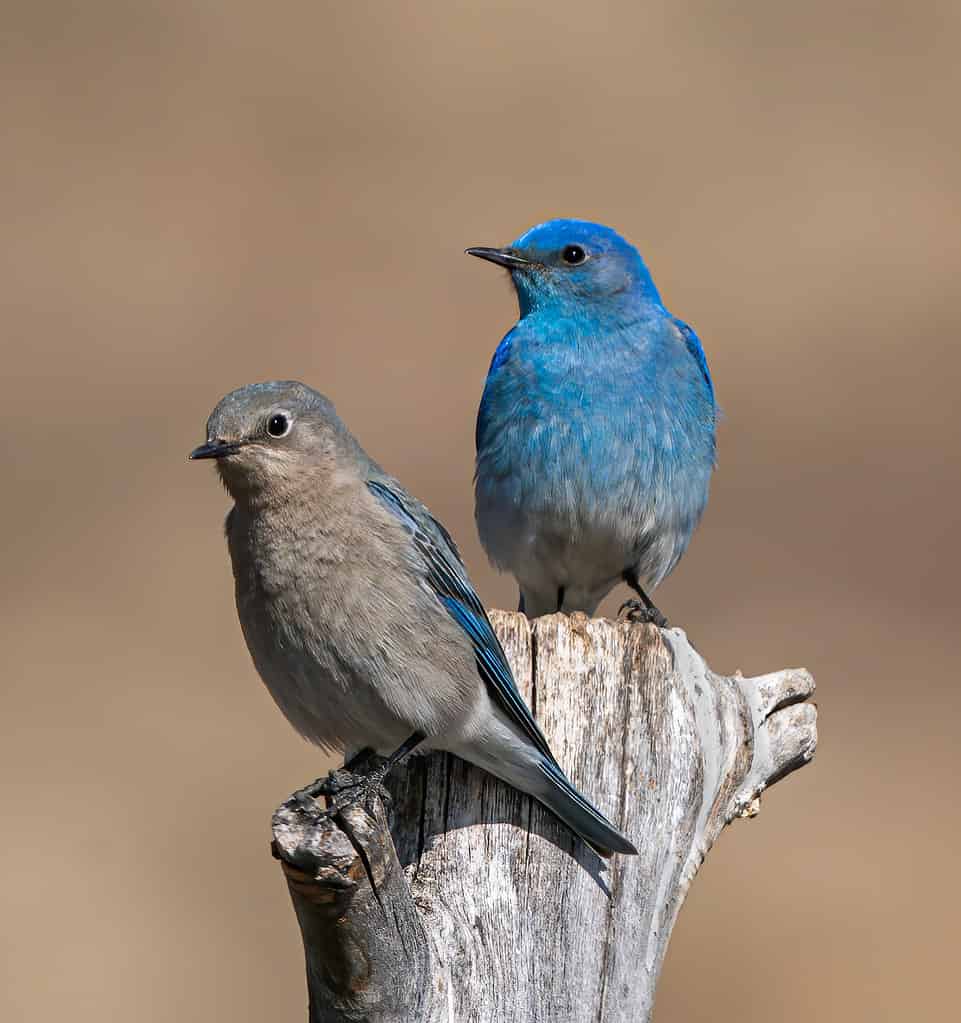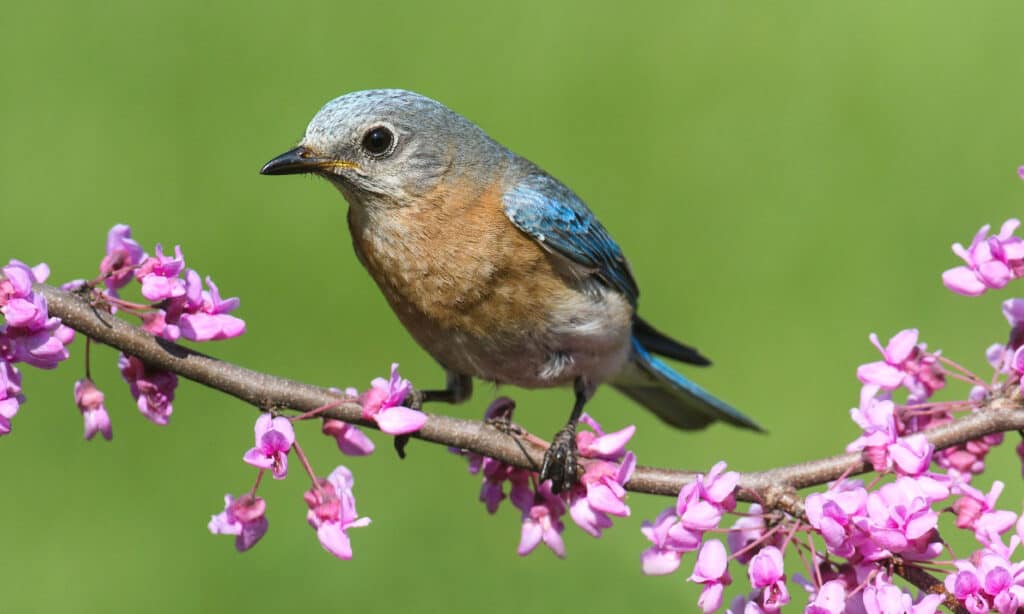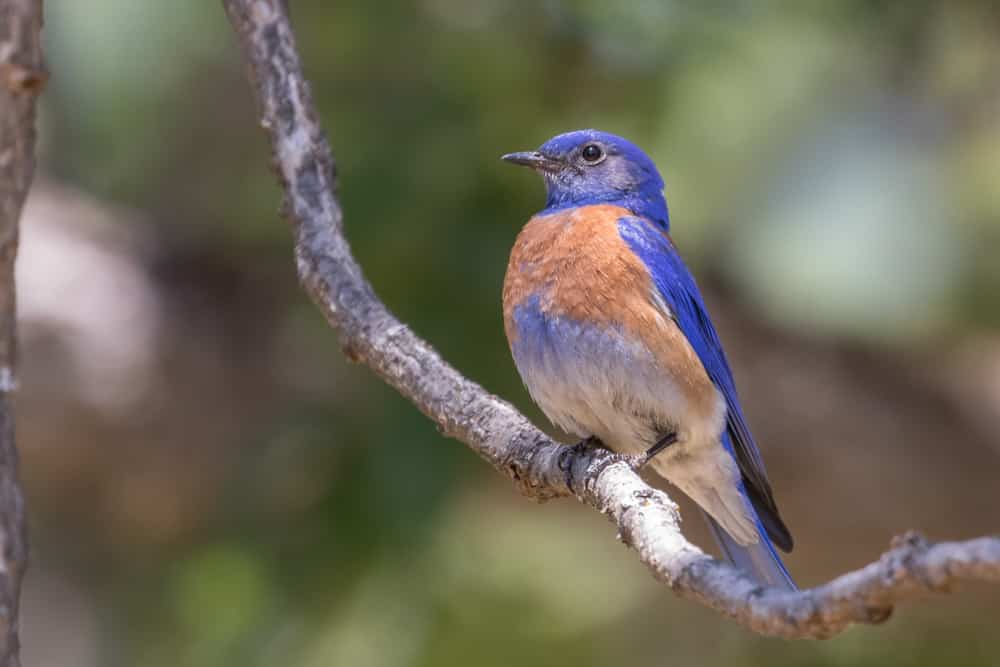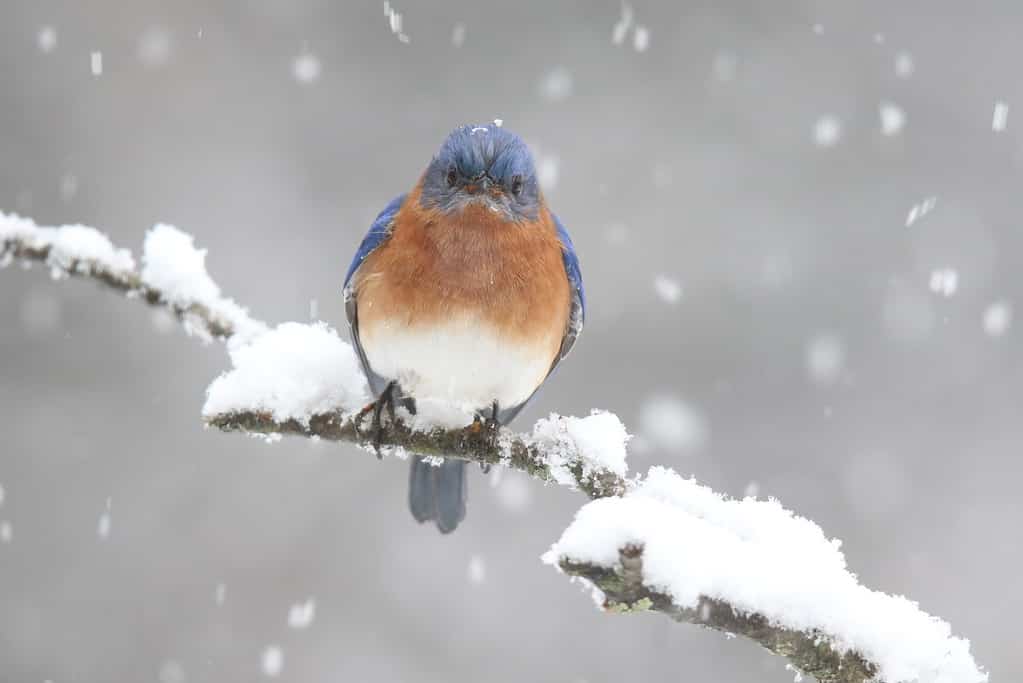Bluebirds are beautiful and captivating birds that bring delight to birdwatchers across the United States. These stunning creatures are known for their vibrant blue feathers and melodious songs. One of the most fascinating aspects of bluebirds is their seasonal migration. In this article, we will explore the patterns, timing, and more behind the captivating phenomenon of bluebird migration in the U.S.
Understanding Bluebird Migration:

A pair of Mountain Bluebirds pause for a rest during their house-hunting expedition.
©Richard Seeley/Shutterstock.com
The migratory journey of bluebirds is a fascinating and awe-inspiring phenomenon. These journeys can span hundreds or even thousands of miles, as bluebirds navigate their way to their wintering grounds and then back to their breeding grounds.
Bluebirds typically migrate in flocks, which provides them with safety in numbers and allows for efficient navigation. They rely on their keen sense of direction, as well as visual landmarks and celestial cues, such as the position of the sun and stars, to guide them during their journey.
The timing of bluebird migration varies depending on the species and the specific geographical region. Eastern Bluebirds, Western Bluebirds, and Mountain Bluebirds have distinct migration patterns and timings.
Bluebird Species in North America:
In North America, three species of bluebirds are commonly found: the Eastern Bluebird (Sialia sialis), the Western Bluebird (Sialia mexicana), and the Mountain Bluebird (Sialia currucoides). Each of these species has its own unique migration patterns and timings.
Eastern Bluebird Migration:

Eastern bluebirds are in the eastern/central regions of the U.S.
©Steve Byland/Shutterstock.com
Eastern Bluebirds are found throughout the eastern and central regions of the United States. During the breeding season, they occupy their territories, but when winter approaches, they begin their migration to warmer regions. The timing of their migration varies depending on the local climate and food availability. In general, Eastern Bluebirds start their migration southward between late September and early October and return to their breeding grounds between February and early April.
Western Bluebird Migration:

The western bluebird sits on a small branch.
©Hayley Crews/Shutterstock.com
Western Bluebirds are primarily found in the western regions of North America. These birds also undertake seasonal migrations to escape harsh winter conditions. Western Bluebirds typically start their migration in late September or early October, heading southward to find milder climates. They can be seen returning to their breeding grounds as early as late February and continuing through April.
Mountain Bluebird Migration:

Adult male Mountain Bluebird (Sialia currucoides) flying at Kamloops, Canada.
©Agami Photo Agency/Shutterstock.com
Mountain Bluebirds are known for their striking blue plumage and are found in the mountainous regions of North America. These bluebirds undertake longer migratory journeys compared to their eastern and western counterparts. They migrate from their breeding grounds in the mountains to more southern regions during winter. Mountain Bluebirds begin their migration in late September or early October, returning to their breeding grounds between late February and early April.
Where Do Bluebirds Go When They Migrate?
It’s important to note that individual bluebirds within each species may exhibit some variation in their migration patterns. Some bluebirds may migrate shorter distances or not migrate at all, depending on factors such as food availability and weather conditions. Additionally, bluebirds may also migrate to other parts of North and Central America, depending on the species and their specific range.
Eastern Bluebird:
Eastern Bluebirds are year-round residents in most of their range in the U.S. They can be found in the eastern and central parts of the country, including the Northeast, Southeast, and parts of the Midwest. While some Eastern Bluebirds may migrate short distances within their range, many remain in their breeding territories throughout the year.
Western Bluebird:
Western Bluebirds are found in the western parts of the United States, including the Pacific Northwest, California, and parts of the Rocky Mountains. During the winter, some Western Bluebirds may migrate to more southern regions within their range, such as southern California or Mexico.
Mountain Bluebird:
Mountain Bluebirds are primarily found in the western parts of North America, including the Rocky Mountains and the western prairies. During the winter, Mountain Bluebirds may migrate to more southern regions within their range, such as the southwestern United States or Mexico.
For more specific information on bluebird migration patterns and destinations, it is recommended to consult local birding resources, birdwatching organizations, or field guides that focus on the specific region of interest.
Factors Influencing Bluebird Migration:

Male Eastern Bluebird perching on a snowy branch in a winter snowstorm.
©iStock.com/suefeldberg
Migration is a remarkable natural instinct that is observed in numerous bird species, including bluebirds. It is a complex behavior that is driven by various factors, such as the availability of food, suitable breeding grounds, and favorable climates. Bluebirds undertake their migratory journeys to ensure their survival and reproductive success.
Food Availability:
Food availability is a key factor influencing the migration patterns of bluebirds. Bluebirds primarily rely on insects as their main food source, especially during the breeding season when they need a high-protein diet to raise their young. As the seasons change, the availability of insects fluctuates. Bluebirds migrate in search of regions where insect populations are abundant and can provide a sufficient food supply.
During the warmer months, when insect populations are plentiful, bluebirds may remain in their breeding grounds. However, as winter approaches and insect activity decreases, bluebirds are compelled to migrate to areas where they can find an ample supply of insects to sustain themselves. By following the availability of their primary food source, bluebirds can ensure their survival and reproductive success.
Weather Conditions:
Weather conditions play a crucial role in bluebird migration. Harsh weather, such as extreme cold or lack of shelter, can prompt bluebirds to migrate earlier or later than usual. Bluebirds are sensitive to temperature changes and require suitable conditions for survival.
During the winter months, when temperatures drop significantly and food becomes scarce, bluebirds migrate to regions with milder climates. These regions offer more favorable conditions, including relatively warmer temperatures and a higher availability of food. By migrating to these areas, bluebirds can increase their chances of survival during the challenging winter season.
Similarly, adverse weather conditions during the breeding season, such as heavy rainfall or prolonged periods of cold, can impact the availability of insects and nesting success. In such cases, bluebirds may alter their migration patterns or adjust their breeding strategies to adapt to the changing conditions.
Suitable Nesting Sites:
The availability of suitable nesting sites is another factor that influences bluebird migration. Bluebirds require specific habitats for nesting and raising their young. These habitats typically consist of open areas with low vegetation, sufficient perching sites, and nearby food sources.
During their migration, bluebirds search for regions that offer these ideal nesting conditions. They look for areas with appropriate nesting sites, such as tree cavities or man-made nest boxes, and suitable foraging grounds nearby. The availability of these nesting sites can influence the timing and destination of their migration, as bluebirds need to find suitable breeding grounds to ensure the successful continuation of their species.
Conservation efforts that focus on providing and maintaining suitable nesting sites, such as installing bluebird nest boxes in appropriate locations, can help support bluebird populations and contribute to their successful migration and breeding.
Monitoring and Conservation Efforts:
Understanding bluebird migration is not only fascinating but also crucial for their conservation. Conservation organizations and bird enthusiasts actively monitor bluebird populations and migration patterns to gather valuable data that can inform conservation efforts.
Citizen science initiatives, such as bluebird nest box monitoring programs, have played a significant role in studying bluebird migration. These programs involve volunteers who monitor bluebird nest boxes, record data on nesting success, and track the arrival and departure of bluebirds during migration. This data helps scientists gain insights into bluebird populations, migration routes, and potential threats they may face along their journey.
In Conclusion:
The annual migration of bluebirds in the United States is a remarkable natural phenomenon. Understanding the patterns and timing of bluebird migration allows us to appreciate the challenges they face and the importance of preserving their habitats. By safeguarding their breeding and wintering grounds, we can ensure the continued survival and well-being of these captivating birds. So, the next time you catch a glimpse of a bluebird perched on a branch, take a moment to appreciate the incredible journey they undertake each year.
The photo featured at the top of this post is © J Zdunczyk/Shutterstock.com
Thank you for reading! Have some feedback for us? Contact the AZ Animals editorial team.







